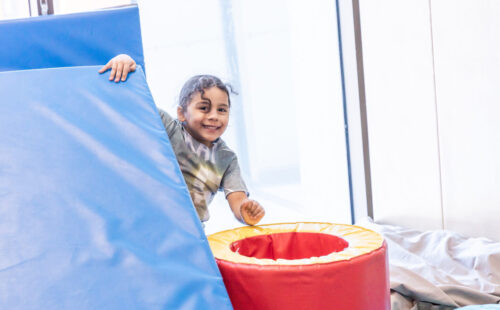Literacy skills are important to school readiness. Research on the long-term effects of early instruction of beginning reading skills shows that engaging in “drill and practice” at an early age undermines children’s disposition to be readers.
At St. David’s Center we focus on the foundational skills of literacy in order to give children strong starts in their literacy journeys. These skills include communication, phonemic awareness, visualization, and enjoyment of books. Here is what this looks like for young children:
Communication
Before children learn to read and write, they learn to communicate using speaking and listening skills. Children are born with a desire to interact with their parents, family members, and other caregivers. Back-and-forth interactions, sometimes referred to as “serve-and-return,” have been shown to be fundamental for healthy brain development, affecting not just literacy but all learning. Here are examples of serve-and-return activities for the first five years of life:
- peek-a-boo with infants and toddlers
- imitating a child’s babbling as they learn to speak
- back-and-forth conversations, in which caregivers repeat the child’s words and phrases
As you can see, the basic serve-and-return is the same, but the content progresses from non-verbal to sounds and from sounds to words. These exchanges should happen throughout the day, both at home and at school.
One exchange our preschoolers engage in is the Daily Message Board. Each morning, the children see two or three messages about the day written with symbols and words. The children talk with the teacher and classmates to decipher the messages. The messages are relevant to the children, so they learn pre-literacy skills in a meaningful context.
Phonemic Awareness
Before children can use letters in a meaningful way, they need to be able to hear the sounds of the English language (and any other language they are learning). They first notice the ending sound of words, then the starting sound, and finally they are able to discern individual syllables. Here is how this typically progresses with children:
- nursery rhymes (first listening and then joining in and reciting)
- creating rhymes (with real or made-up words)
- noticing words that start with the same sound
- inventing spellings (attempting to write words by sounding them out)
Our preschoolers use Letter Links to help them notice how the starting sounds of their names share the starting sounds of other words, such as Mike/mitten. This builds on the tendency of children to learn the letters of their own name first.
Visualization
Visualizing may not be as obvious a literacy skill because this skill becomes more important starting around fourth grade. K-3 literacy focuses on reading materials with the goal of learning to read, often with illustrations to assist in this. Starting in fourth grade, most reading goals and materials focus on reading for other learning. There is evidence that children who spent a significant amount of time pretending as preschoolers start to out-perform children who spent more time on “drill-and-practice” skills, such as “Letter of the Week.” These children are able to visualize a different place (e.g. ancient Egypt) while they read about it.
The good news is that the activities to build this skill are possible to do at home and school. Here are a few ways to foster visualization:
- Encourage engagement in lots of pretend play (alone, with adults, and with peers).
- Talk to your child about what is going to happen.
- Toddlers can typically keep in mind what is happening next.
- Young preschoolers can keep in mind things happening later in the day.
- Older preschoolers can keep in mind things happening in the next few days .
- Talk to your child about experiences after the fact — e.g. “Remember when we saw the dog on our walk?”
We use a picture schedule in our classrooms so children can start to visualize the recent-past and the near-future. Our preschoolers talk about their plans and recall what they did every day before and after Work Time.
Enjoyment of Books
Lifelong readers are created by an early love of books, and that starts with the bond created when they read with loved ones. Cuddling with a young child and reading to them has been shown to improve reading skills later in life, while also strengthening attachment.
The conversations adults have with children about stories are as important as the words themselves. If a child points at an illustration (or later a word), the adult should respond. The adult can ask questions such as, “What do you think will happen next?” The conversation should stay relaxed and not become a quiz.
Our preschoolers have a time set aside every day, in which a teacher reads to them in a small group. This read-aloud time is a small part of the day, but it is an effective way to foster reading skills in young children.
All of these foundational literacy skills are important for children, not just to be successful in school, but also to be lifelong readers and lifelong learners.
For more info on St. David’s Center’s Early Childhood Education, click here.
If you need book ideas for story time, check out this list of recommendations from our archives.
For more on Serve-and-Return, you can check out this recent Ted Talk:
Molly Wright: How every child can thrive by five | TED – YouTube
